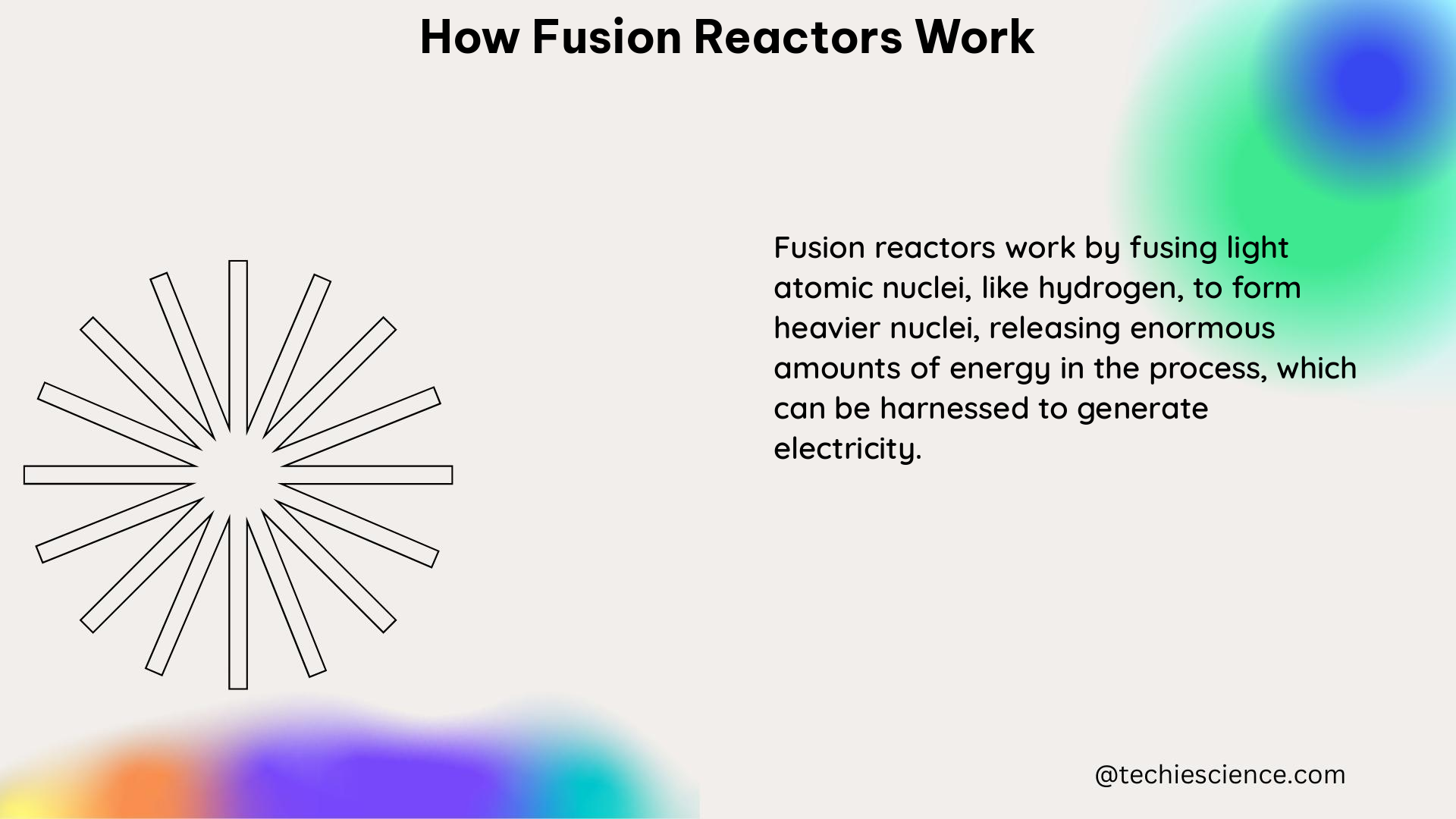Fusion reactors harness the energy released when atomic nuclei fuse together, a process that powers the sun and stars. This process involves heating hydrogen isotopes, such as deuterium and tritium, to extremely high temperatures, causing them to become a plasma. Under these conditions, the repulsive electrostatic forces between the positively charged nuclei are overcome, allowing them to fuse and release a substantial amount of energy.
The Fusion Reaction
The most common fusion reaction is the deuterium-tritium (D-T) reaction, which releases 17.6 MeV (2.8 x 10^-12 joule) of energy per reaction. This is over four times the energy released by a uranium fission reaction, making fusion a highly efficient source of energy.
The fusion reaction can be represented by the following equation:
2D + 3T → 4He (3.5 MeV) + n (14.1 MeV)
In this reaction, two deuterium (2D) nuclei and one tritium (3T) nucleus fuse to form one helium (4He) nucleus and one neutron (n). The energy released is primarily in the form of kinetic energy of the helium nucleus (3.5 MeV) and the neutron (14.1 MeV).
Plasma Confinement

To achieve fusion, the plasma must be confined for long enough and under sufficient pressure for the nuclei to fuse. This is typically done using magnetic confinement, where strong magnetic fields are used to hold the plasma in place and prevent it from coming into contact with the walls of the reactor.
The most common magnetic confinement device is the tokamak, which uses a toroidal (doughnut-shaped) magnetic field to confine the plasma. The magnetic field is generated by a combination of external coils and a current flowing through the plasma itself.
Another type of magnetic confinement device is the stellarator, which uses a more complex, three-dimensional magnetic field to confine the plasma. Stellarators are generally more stable than tokamaks but are also more challenging to design and construct.
Key Performance Measures
One key measure of fusion reactor performance is the energy confinement time (τE), which measures how well the magnetic field insulates the plasma. A larger τE means that the reactor will be more effective at producing net power.
The energy confinement time can be calculated using the following formula:
τE = 3nkBT / (P - dW/dt)
Where:
– n is the plasma density
– kB is the Boltzmann constant
– T is the plasma temperature
– P is the total power input to the plasma
– dW/dt is the rate of change of the plasma energy content
Another important measure of fusion reactor performance is the energy gain (G), which is defined as the ratio of the fusion power produced to the external heating power required to maintain the reaction. At sufficient pressure, the plasma is entirely self-heated, and G > 1, a condition known as ignition. High gain is essential for commercial fusion as it reduces the need for external heating and simplifies reactor design.
The energy gain can be calculated using the following formula:
G = Pfusion / Pext
Where:
– Pfusion is the fusion power produced
– Pext is the external heating power required
Plasma Power Balance
In steady state, the power balance in the fusion plasma is given by the equation:
P = Pext + Pα - Ploss
Where:
– P is the total power in the plasma
– Pext is the external heating power density
– Pα is the power produced by fusion reactions
– Ploss is the power lost due to turbulent transport across the magnetic field
The ‘fusion product’ (PτE) and the temperature (T) determine the energy gain of the fusion device. In the temperature range of 100-200 million degrees Celsius, ignition occurs when PτE > 20.
Fusion Performance Plot
The ‘fusion performance plot’ of power (P) versus temperature (T) shows the breakeven point (Q=1) and data points from different tokamaks, indicating the substantial progress towards power station conditions that has been achieved in recent decades.

The plot shows that as the fusion product (PτE) and temperature (T) increase, the fusion power (P) also increases, indicating the progress towards achieving ignition and high-gain fusion.
Challenges and Future Developments
While fusion reactors hold great promise as a clean and efficient source of energy, there are still significant challenges that need to be overcome before they can be commercially viable. These include:
- Achieving and maintaining the high temperatures and pressures required for fusion to occur
- Developing materials that can withstand the extreme conditions inside a fusion reactor
- Improving the efficiency and reliability of the magnetic confinement systems
- Reducing the cost of building and operating fusion reactors
Despite these challenges, research and development in fusion technology continues to make steady progress, and many experts believe that commercial fusion power could be a reality within the next few decades.
References
- Nuclear Fusion Power, World Nuclear Association, https://world-nuclear.org/information-library/current-and-future-generation/nuclear-fusion-power.aspx
- Measuring fusion power – ITER.org, ITER Organization, https://www.iter.org/newsline/150/451
- The path to fusion power – PMC – NCBI, National Center for Biotechnology Information, https://www.ncbi.nlm.nih.gov/pmc/articles/PMC3263804/
- Fusion Reactor Design, Massachusetts Institute of Technology, https://web.mit.edu/22.63/www/Lecture1.pdf
- Fusion Energy, U.S. Department of Energy, https://www.energy.gov/science/articles/fusion-energy-future
I am Keerthi K Murthy, I have completed post graduation in Physics, with the specialization in the field of solid state physics. I have always consider physics as a fundamental subject which is connected to our daily life. Being a science student I enjoy exploring new things in physics. As a writer my goal is to reach the readers with the simplified manner through my articles.